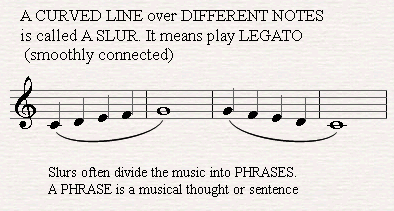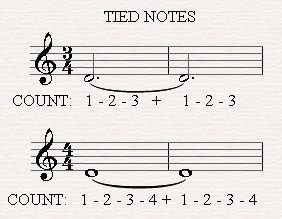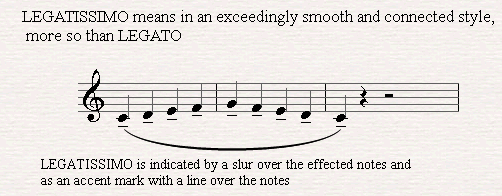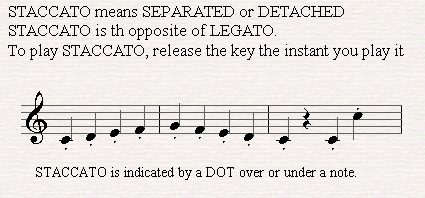Accent Marks
Home » Piano Technique » Musical Phrasing
1. Playing Legato

In music the Italian word "Legato" (literally meaning tied together") indicates that musical notes are played or sung smoothly. In other words when you play legato there should be no silence between when moving from note to note.
You have to perform a musical line in a graceful, connected style, as opposed to staccato. It is often indicated by a slur over the effected notes or as a line over the notes to be performed in this manner.
The accurate way to perform a legato on the piano is by pressing a finger, then pressing on another finger and while the second finger is pressed half way on the piano key you raise the first finger up.
The slur has two meanings in musical pieces. The first one indicate that a musical phrase should be played legato and the second meaning is to state the beginning and the ending of a musical line.
So if you happen two see two notes in the middle of a slur you could wonder how it's possible to play them legato since you must raise you finger up.
The answer is that you have to imagine the line as a whole and keep the first note pressed on the key as long as you can before you raise it up to the next key.
- Accent Marks -
One shouldn't however mix playing legato with TIED NOTES

When notes on the SAME LINE or SPACE are joined by a curved line, we call them TIED NOTES.
The key is held down for the COMBINED VALUES OF BOTH NOTES.
2. Playing Legatissimo
 Play
Play
When we're asked to play Legatissimo we're supposed to perform a certain passage in an exceedingly smooth and connected manner more so than legato. Legatissimo is often played in ballads in order to create a warm and intimate expression in the melody.
The accurate way to play the Legatissimo on the piano is by pressing a finger down, the pressing on another finger, keeping them both pressed for a slice of a moment before raising the first finger up (and not half way of the piano key like legato.)
- Accent Marks -
3. Performing a musical phrasing of Staccato

The Italian word Staccato (literally detached) indicates that notes are separated in a detached and distinctly separate manner. In other words there is an interval of silence between every two notes but the rhythm is not affected by it.
When you see the Staccato musical phrasing sign you should basically press down a finger and create a relative short tone length then raise your finger and press the other finger after the first finger left the key completely.
4. Playing Staccatissimo

- Accent Marks -
Staccatissimo is a style of playing notes in a detached, separated, distinct manner that shortens the notated duration of the note in a more exaggerated way than normal staccato. The tone length of each note is very short.
You can compare it to pizzicato in strings which mean that you pluck a string rather then playing on it with a bow. The sound is more affected by the attack then the duration of the note.
You can perform this way of playing by pressing on a piano key as quickly as you can without staying enough time to create a real tone length.
- Accent Marks -
How to Practice These Four Accent Marks?
Here's a handy way to practice these new musical phrasings we've learned.
Right Hand: Place your first finger on Middle C, the second finger on D and so on compatibly.
Start with passing from one piano key to the other in a Legato manner.
Bring your first finger down to middle C, and then bring the second finger to D.
When the second finger is pressed half way down raise your first finger up while you press the second finger down fully. Make sure there isn't any pause between the two keys.
- Accent Marks -
Left Hand: Now repeat the process with your left hand. This time put your fifth finger on the lower C and the other finger compatibly.
Counter Movement: When you're done try to play this exercise in a counter movement. Place both your thumbs on middle C and move to the second finger of both hands at the same time. In counter movement both hand are using the same finger but playing different notes.
Parallel movement: Parallel movement is a bit more difficult since you know have to use different finger while you're playing the same notes.
Put your right hand first finger on middle C and the other fingers compatibly. At the same time place your left hand fifth finger on the lower C and other finger compatibly. Press the right hand first finger and left hand fifth finger at the same time.
Move to the right hand second finger and the left hand fourth finger at the same time in a legato way (make sure there isn't any pause in between).
To conclude, every E.D (every day) exercise should be played in four different ways. Starting with the right hand apart, going to the left hand, counter movement and finally parallel movement.
Double that with the four ways we've learned and you'll see that you have plenty of work for the coming weeks :)
- Accent Marks -
Playing Different Musical Phrasings on Each Hand
The next piano exercise is for more advanced piano students. Once you're able to play the different four ways to connect between the keys try to challenge yourself by playing different accent marks on each hand.
Place your hand in the same position as you did with the basic exercise on both hands.
Play legato with the right hand and staccato with the left hand all the way up and down.
Then switch sides and let the left hand play legato while the right hand is playing staccato. It's quiet a task to command the right hand not to leave the finger from the key while the left hand needs to jump from one key to the other.
- Accent Marks -
Here are a few piano pieces that will help you to practice the different musical pharsings.
| Jingle Bells | Download | |
| Bingo | Download | |
| Surprise Symphony by Haydn | Download | |
| Twinkle Twinkle | Download |
Done? Great! Here's the next piano lesson about the dotted half note. We're going to cover a new time signature as well. Click here to learn about the Dotted Half Note.
Return from Musical Phrasings Signs to Piano Technique














